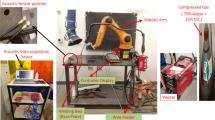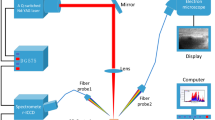Abstract
Detecting laser metal deposition (LMD) defects is a key element of evaluating the probability of failure of the produced part. Acoustic emission (AE) is an effective technique in LMD defect detection. This work presents a systematic experimental investigation of using AE technique for detecting and classifying different defects in LMD. The defects generated during LMD simulate AE sources on deposited material while the AE sensor was mounted on the substrate to capture AE signals. An experiment was conducted to investigate the ability of AE to detect and identify defects generated during LMD using a logistic regression (LM) model and an artificial neural network (ANN). AE features, such as peak amplitude, rise time, duration, energy, and number of counts along with statistical features were extracted and analyzed. Additionally, frequency analysis using fast Fourier transformation was conducted on the AE signal. The results show that AE has considerable potential in LMD monitoring for assessing the overall deposition quality and identifying defects that can significantly reduce the strength and reliability of deposited material, and consequently, increase the risk of a component’s failure.
Similar content being viewed by others
References
Wang L, Felicelli SD, Craig JE (2009) Experimental and numerical study of the LENS rapid fabrication process. ASME J Manuf Sci Eng 131(4):041019-8. doi:10.1115/1.3173952
Weerasinghe VM, Steen WM (1983) Laser cladding by powder injection. In: Chen JMMM Chen, Tucker C (eds) Transport phenomena in materials processing, ASME, New York, pp 15–23
Weerasinghe V, Steen W (1987) Laser cladding with blown powder. Met Constr 19:581–585
Sears JW (1999) Direct laser powder deposition - ‘State of the Art’. No. KAPL-P-000311; K99089 Knolls Atomic Power Lab, Nis, NY
McLean M (1997) Laser direct casting high nickel alloy components. Adv Powder Metall Part Mater 3:21
Mazumder J, Choi J, Nagarathnam J, Koch K, Hetzner D (1997) The direct metal deposition of H13 tool steel for 3D components. JOM 49:55–60
Lewis G, Nemec R, Milewski J, Thoma D (1994) Directed light fabrication, No. LAUR–94-2845; CONF-9410189–2, Los Alamos Natl. Lab., NM, USA
Milewski J, Lewis G, Thoma D (1998) Directed light fabrication of a solid metal hemisphere using 5-axis powder deposition. J Mater Process Technol 75:165–172
Wu X, Liang J, Mei J, Mitchell C, Goodwin PS, Voice W (2004) Microstructures of laser-deposited Ti-6Al-4V. Mater Des 25:137–144
Arcella F, Froes F (2000) Producing titanium aerospace components from powder using laser forming. JOM 52:28–30
Fessler JR, Merz R, Nickel AH, Prinz FB (1996) Laser deposition of metals for shape deposition manufacturing. In: Proceedings of the Solid Freeform Fabrication Symposium, University of Texas, Austin, pp 117–124
Keicher DM, Miller WD (1998) LENS moves beyond RP to direct fabrication. Met Powder Rep 53:26–28
Griffith M, Schlienger M, Harwell L (1998) Thermal behavior in the LENS process, No. SAND–98-1850C; CONF-980826. Sandia Natl. Labs, Albuquerque
Xue L, Islam M (1998) Free-form laser consolidation for producing functional metallic components. Laser Inst. Am. Laser Mater Process 84
Xue L, Islam M (2000) Free-form laser consolidation for producing metallurgically sound and functional components. J Laser Appl 12:160–165
Ma Z, Sun G, Liu D, Xing X (2016) Dissipativity analysis for discrete-time fuzzy neural networks with leakage and time-varying delays. Neurocomputing 175(Part A):579–584
Gaja H, Liou F (2016) Automatic detection of depth of cut during end milling operation using acoustic emission sensor. Int J Adv Manuf Technol 86(9–12):2913–2925
Duro JA, Padget JA, Bowen CR, Alicia Kim H, Nassehi A (2016) Multi-sensor data fusion framework for CNC machining monitoring. Mech Syst Signal Process 66–67:505–520
Jolly, W. D. (1969) Acoustic emission exposes cracks during welding processes. Welding J 48
Rostek W (1990) Investigations on the connection between the welding process and airborne noise emission in gas shielded metal arc welding. Schw und Schn 42(6):E96–E97
Duley WW, Mao YL (1994) The effect of surface condition on acoustic emission during welding of aluminum with CO2 laser radiation. J Phys D Appl Phys 27:1379
Grad L, Kralj V (1996) On line monitoring of arc welding process using acoustic signals. In: Proceedings of the 13th Conference BIAM’96, Zagreb, pp i17–i20
Van Bohemen SMC, Hermans MJM, Den Ouden G (2001) Monitoring of martensite formation during welding by means of acoustic emission. J Phys D, Appl Phys (UK) (22):3312–3317
Grad L, Grum J, Polajnar I, Slabe JM (2004) Feasibility study of acoustic signals for on-line monitoring in short circuit gas metal arc welding. Int J Mach Tools Manuf 44(5):555–561
Yang Z, Yu Z, Wu H, Chang D (2014) Laser-induced thermal damage detection in metallic materials via acoustic emission and ensemble empirical mode decomposition. J Mater Process Technol 214(8):1617–1626
Diego-Vallejo D, Ashkenasi D, Eichler HJ (2013) Monitoring of focus position during laser processing based on plasma emission. Phys Procedia 41:911–918
Wang F, Mao H, Zhang D, Zhao X, Shen Y (2008) Online study of cracks during laser cladding process based on acoustic emission technique and finite element analysis. Appl Surf Sci 255 (5, Part 2): 3267–3275
Siracusano G, Lamonaca F, Tomasello R, Garesci F, La Corter A, Cani DL, Carpentieri M, Grimaldi D, Giovanni F (2016) A framework for the damage evaluation of acoustic emission signals through Hilbert–Huang transform. Mech Sys Signal Process 75:109–122
Bianchi D, Vernes A (2015) Wavelet packet transform for detection of single events in acoustic emission signals. Mech Syst Signal Process 64–65:441–451
Gaja H, Liou F (2016) Defects monitoring of laser metal deposition using acoustic emission sensor. Int J Adv Manuf Technol:1–14
Cox DR (1958) The regression analysis of binary sequences. J R Stat Soc Ser B Methodol 20(2):251–242
Barua S et al (2014) Vision-based defect detection in laser metal deposition process. Rapid Prototyp J 20(1):77–85
Author information
Authors and Affiliations
Corresponding author
Rights and permissions
About this article
Cite this article
Gaja, H., Liou, F. Defect classification of laser metal deposition using logistic regression and artificial neural networks for pattern recognition. Int J Adv Manuf Technol 94, 315–326 (2018). https://doi.org/10.1007/s00170-017-0878-9
Received:
Accepted:
Published:
Issue Date:
DOI: https://doi.org/10.1007/s00170-017-0878-9




